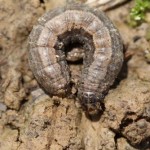Cutworms are a very sporadic but potentially damaging pest in seedling corn. The black cutworm is the most common culprit, but other species may also occur. Cutworms tend to be more problematic in reduced-till situations. However, they can also occur in conventionally tilled fields. Tillage will destroy weedy hosts and directly kill cutworms, but that is only a good bet on fields that are well tilled during the spring, prior to planting. The potential for cutworm infestations increases substantially in fields where weedy vegetation persists within 2-3 weeks prior to planting. Thus, one of the best things to do is apply your herbicide burndown well in advance of planting (4 weeks or more, allowing any weedy vegetation to die). Bt corns such as Herculex and Genuity VT3 Pro offer some protection but may not be adequate if cutworm populations are high, especially if large larvae are present.
A common and relatively inexpensive practice is to apply insecticide preventatively for the control of cutworms, and this is an especially good idea in fields where burndown herbicides were applied within 2-3 weeks of planting. Applying insecticide with your burndown application does not make a lot of sense if you are 2-4 weeks ahead of planting. Many larvae present at that time would have likely cycled out before planting anyhow, and there is a possibility of re-infestation. Consider applying insecticides for cutworm control close to planting, even behind the planter. You can save some cost by banding your application, but try to keep the band a minimum of 7-10 inches wide.
Many insecticides are labeled for cutworm control, but synthetic pyrethroids are a standard treatment. These include products like Asana XL, Baythroid XL, Declare, Karate/Warrior II, and Mustang Max. Note that Ammo or generic equivalents are not labeled for use in corn. Suggested insecticides and rates for control of cutworms can be found in UT’s Insect Control Recommendations for Corn.


